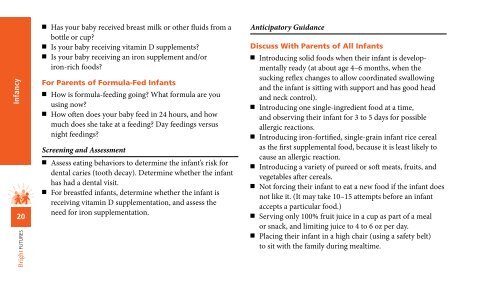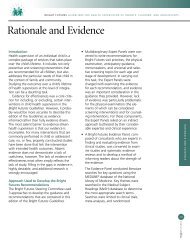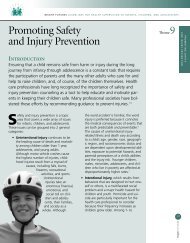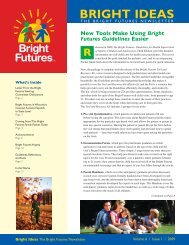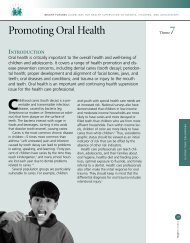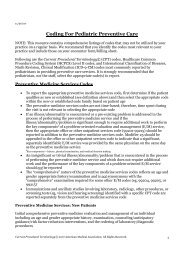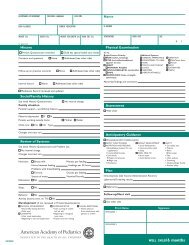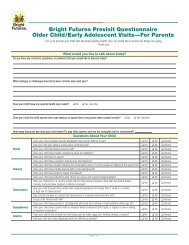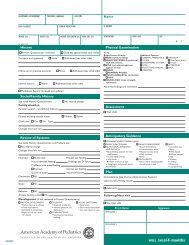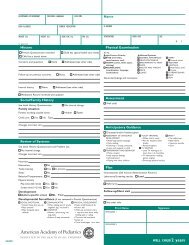POCKET GUIDE - Bright Futures - American Academy of Pediatrics
POCKET GUIDE - Bright Futures - American Academy of Pediatrics
POCKET GUIDE - Bright Futures - American Academy of Pediatrics
You also want an ePaper? Increase the reach of your titles
YUMPU automatically turns print PDFs into web optimized ePapers that Google loves.
Infancy<br />
20<br />
<strong>Bright</strong> FUTURES<br />
■ has your baby received breast milk or other fluids from a<br />
bottle or cup?<br />
■ is your baby receiving vitamin D supplements?<br />
■ is your baby receiving an iron supplement and/or<br />
iron-rich foods?<br />
for Parents <strong>of</strong> formula-fed infants<br />
■ how is formula-feeding going? What formula are you<br />
using now?<br />
■ how <strong>of</strong>ten does your baby feed in 24 hours, and how<br />
much does she take at a feeding? Day feedings versus<br />
night feedings?<br />
Screening and Assessment<br />
■ Assess eating behaviors to determine the infant’s risk for<br />
dental caries (tooth decay). Determine whether the infant<br />
has had a dental visit.<br />
■ For breastfed infants, determine whether the infant is<br />
receiving vitamin D supplementation, and assess the<br />
need for iron supplementation.<br />
Anticipatory Guidance<br />
discuss with Parents <strong>of</strong> all infants<br />
■ introducing solid foods when their infant is developmentally<br />
ready (at about age 4–6 months, when the<br />
sucking reflex changes to allow coordinated swallowing<br />
and the infant is sitting with support and has good head<br />
and neck control).<br />
■ introducing one single-ingredient food at a time,<br />
and observing their infant for 3 to 5 days for possible<br />
allergic reactions.<br />
■ introducing iron-fortified, single-grain infant rice cereal<br />
as the first supplemental food, because it is least likely to<br />
cause an allergic reaction.<br />
■ introducing a variety <strong>of</strong> pureed or s<strong>of</strong>t meats, fruits, and<br />
vegetables after cereals.<br />
■ Not forcing their infant to eat a new food if the infant does<br />
not like it. (it may take 10–15 attempts before an infant<br />
accepts a particular food.)<br />
■ serving only 100% fruit juice in a cup as part <strong>of</strong> a meal<br />
or snack, and limiting juice to 4 to 6 oz per day.<br />
■ Placing their infant in a high chair (using a safety belt)<br />
to sit with the family during mealtime.


